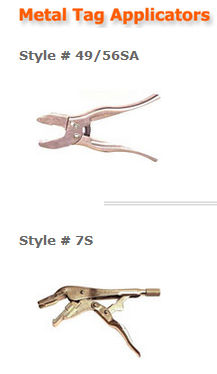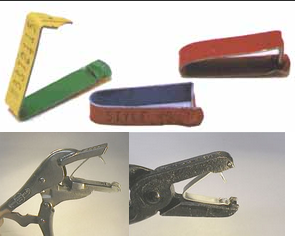In March of 2013, the United States Department of Agriculture (USDA) Cattle Identification rules were implemented requiring all cattle 18 months old or older be identified for interstate (across state line) transportation. Beef cattle under 18 months of age, unless they are moved interstate for shows, exhibitions, rodeos, or recreational events, are exempt from the official identification requirement in this rule. The purpose of adult cattle and bison identification is simply to provide trace-back to the original owner, in the event of a serious animal disease outbreak, such as tuberculosis (TB), mad cow disease (BSE), or hoof and mouth disease. In response to the USDA’s rule, states have been developing rules for cattle identification for intrastate (within state) transportation. Florida’s cattle identification rule will be implemented in 2014.
The Florida Cattle Identification Rule 5C-31.005
- Required Identification for Intrastate Movement. Cattle & Bison 18 months of age or older, moving within the state of Florida, must have official individual identification unless the cattle are:
- Being moved directly to a Recognized Slaughter Establishment or through no more than one USDA approved livestock facility and then to a recognized slaughter facility;
- Being moved directly to an approved tagging site; or
- Being moved from one premises to another premises with the cattle remaining under common ownership as part of normal farm or ranching operations. Cattle shall not be commingled with cattle under separate ownership.
The Florida Department of Agriculture’s (FDACS) Division of Animal Industry is the agency charged with developing, implementing, and regulating the Florida Cattle ID Rule. The rules established by FDACS for Florida match those set up by USDA. The basic concept is that all adult cattle and bison (18 months old or older) being transported or sold must have an approved official USDA identification deceive or tag, unless they are going directly to a slaughter facility. This rule does not apply to weaned calves or stocker cattle under 18 months of age. It also does not require that cows be tagged while they remain on the ranch of origin. USDA tags are only required before they are transported to a new owner. The rule even allows cattle producers to have their cattle tagged at livestock markets that become approved tagging sites. Ranchers who do not have a squeeze-chute or head-catch, will be able to have cattle tagged at local markets prior to sale. Also there is no requirement of the new owner to document the tags or keep record of them. If the tag falls out, it will only need to be replaced when the new owners decides to sell the cow or bull, and that tag will be assigned to their ranch premise.
This will be a fairly simple system for commercial cow-calf operations. Cattle ranches will have to register with FDACS and get a premise identification number (PIN) that will be kept on a computer database. Premise registration provides basic ranch contact information and the physical location of the ranch headquarters, which will be entered in the USDA database. As Official USDA Identification Devices (tags) are ordered or purchased, the unique numbers will be assigned to that premise identification number. The official USDA metal tags can be ordered and provided at no charge from USDA. These clamp-on metal tags are very similar to the ones used previously by USDA for brucellosis vaccination identification. Ranchers will also have the option to purchase official, USDA approved, visual and radio frequency identification (RFID) tags from private companies. Some operations may choose to purchase uniquely numbered official plastic ear tags, or RFID tags, so they can be used for ranch record keeping, while also complying with the new state and federal rules. However, the complimentary USDA metal tags will meet the minimum requirements of the rules. Purebred animals with accompanying registration papers, and truly unique individual identification brands or tattoos, will also be accepted as individual identification under both the state and federal rules.
USDA and FDACS will then have the ability to trace an animal back to the farm of origin, if the need arises. Ranches will not be required to keep a record of tags and cattle movement. While this system will not provide a perfect trace-back or ownership path, it does provide USDA with ability to identify the farm of origin, and at least have a starting point for determining farms that may have had contact with a diseased or suspect animal.
Compliance with the Cattle ID Rule can be managed with a few basic steps:
- Register your premise: Premise Application Form.
- Have cattle tagged at an approved livestock market or tagging site on an as needed basis. Be aware that there may charges for this service, so it is advisable to get details from individual markets prior to delivering untagged cattle the first time.
- Select the type of tags you want to use and do it yourself: USDA Approved Visual or RFID Tags or free USDA metal tags.
- Complimentary USDA metal tags orders can be made to directly through:
Stephen Monroe – (850) 410-0944
or the Livestock Inspector serving your district.
-
 District 1 – Escambia, Santa Rosa, Okaloosa,Walton, Holmes, Washington, Bay, Jackson, Calhoun,Gulf, Gadsden, Liberty, Franklin, Leon and Wakulla counties contact:Manny Egusquiza – 850-718-0459
District 1 – Escambia, Santa Rosa, Okaloosa,Walton, Holmes, Washington, Bay, Jackson, Calhoun,Gulf, Gadsden, Liberty, Franklin, Leon and Wakulla counties contact:Manny Egusquiza – 850-718-0459 -
District 2 -Jefferson, Taylor, Madison, Hamilton, Suwannee, Lafayette, Columbia, Baker, Union,Bradford, Alachua, Nassau, Duval, Clay and St. Johns counties contact:
Dana DeJarnatt – 386-362-1775
- Purchase USDA approved visual or RFID tags from livestock supply companies, which will register tag numbers with USDA assigned to the purchasing ranch premise.
- Complimentary USDA metal tags orders can be made to directly through:
- Purchase tagging pliers for the type of tags selected. The free metal tags are manufactured by Hasco and the specific applicators to fit them are: Hasco Style # 7S (recommended) and Hasco Style #49/56SA. These pliers are approximately $20-30 each. District Livestock Inspectors will have pliers that can be loaned out on an as needed basis.
- Tag cows, bulls, or heifers over 17 months old prior to transportation or sale to a new owner. Tagging cattle that will remain on the ranch is optional, but not required under the new Florida Rule.
 For specific information on the federal and state rules contact Stephen Monroe – (850) 410-0944, or go to the following websites:
For specific information on the federal and state rules contact Stephen Monroe – (850) 410-0944, or go to the following websites:
Florida Cattle Identification Rule
USDA Disease Traceability Rules
 0
0



